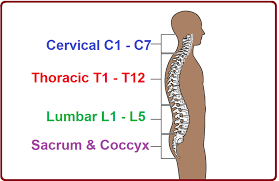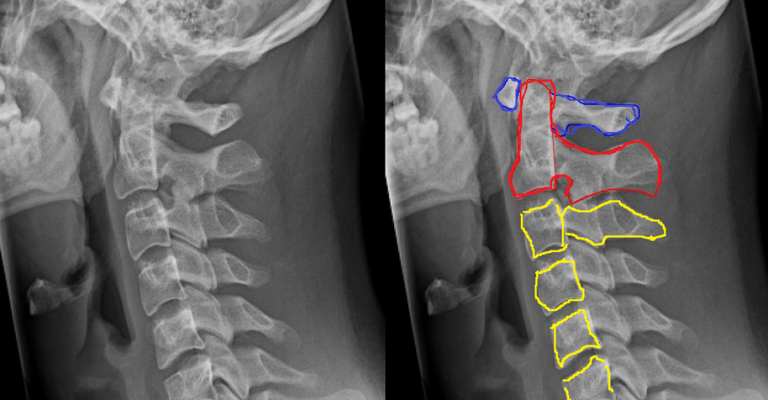Imagine having to suffer a spinal cord injury. It’s a long and difficult path. They all can alter lives, some very drastically. Let’s take a closer look. There is one variety of SCI which always tends to lead the scoreboard as being the most dangerous.
And it’s when the injury occurs in a particular place, particularly the cervical spinal cord. More precisely, when the damage occurs at the C1 and C2 levels of the spinal cord. It is considered to be the worst form of injury to your spinal cord.
Anatomy of Spinal Canal
The spinal cord is a hub of nerve tissues that starts from the bottom of our brain and runs down our back. This vital portion of our body plays the role of a messenger by transferring the brain’s instructions to the rest of the body. In other words, it controls the movements and sensations of our body. The injury to the spinal cord may mix up these messages, which may hinder the ability to move or feel.
Coming to a specific region, the neck contains the cervical portion of the spinal cord. It is included in the top seven vertebrae, called cervical vertebrae. The spinal nerves come out in pairs from these, passing above the vertebrae they originate.
Particular Vertebrae C1 and C2 Now, let’s get on with the vertebrae C1 and C2. These are the two most minor vertebrae, yet these bear an enormous burden-they are what allow us to move our heads.
C1 Vertebrae
Starting at the top of our spinal column is the C1 vertebra, also known as the atlas. It is directly attached to the base of our skull, known as the atlanto-occipital joint, which allows our heads’ forward and backwards nodding.
Just below the atlas is the C2, or axis, vertebra. This vertebra is unique because it contains a small, peg-like extension called the dens. Interestingly, the dens project superiorly toward the atlas, forming an unusual joint that allows us to rotate our heads from side to side.
It is not infrequent that trauma of both the atlas and axes occur because of their intimate relation. The most critical functions of C1 and C2 include providing support to the skull, allowing neck movements, and protecting the spinal cord.
The C1 spinal nerves are slightly different from other pairs of spinal nerves, located just above the atlas. Generally, all other pairs of spinal nerves possess a sensory segment responsible for sending all sensory information to the brain and a motor portion accountable for commanding the muscles. In the usual configuration of C1 nerves, there is only the latter.
C2 Vertebrae
C1 and C2 supply the nuchal muscles responsible for head nodding. The only difference lies in that C1 nerves do not provide any afferent sensation, meaning there is no region of sensation associated with them.
With a C1 spinal cord injury, messages of the C1 spinal nerves can still travel from the brain to other parts of the body. However, all the sensory and motor messages that travel below the point of the injury may be affected. It may even cause one to lose sensation and movement of the neck, arms, legs, and trunk.
Diagnosis of C1 Spinal Cord Injury

Quite simply, a C1 spinal cord injury means an injury to the very top portion of the spinal cord. It controls the body’s movement and sensation, except for the face. This is so because any message from the brain to parts of the body below the injury site gets stopped right at those damaged areas of the spinal cord.
In the event of spinal cord damage, physicians rely on a standardized test known as the American Spinal Injury Association-ASIA Exam. This test informs them about the exact location and the extent of the injury.
The term “level of injury” refers to the lowest level of the spinal cord below which sensation and motor control are intact. In the case of a C1 spinal cord injury, the functions associated with the C1 spinal nerves remain intact.
However, all other motor and sensory modalities may be impaired because the signals from the brain to the body cannot pass through the damaged segments of the spinal cord. However, the amount of function a person may have after that type of injury is directly related to the extent of the damage.
Complete C1 Spinal Cord Injury
The most severe form of injury is a complete one. In this case, the spinal cord is completely severed. In such a case, all the connections from the brain to those parts of the body that are distal to the place of injury are cut; therefore, a total loss of motor activity and sensation occurs.
Incomplete C1 Spinal Cord Injury
In incomplete SCI, the spinal cord is only partially damaged at that particular injury site. In this case, some neural connections are saved when there is an incomplete injury, enabling small communication between the brain and areas below the injury site. Because of this, individuals with incomplete spinal injuries still may have some movement and sensation.
The ASIA exam gauges the severity of the spinal cord injury. Though this is hardly ever done, doctors rely on a CT scan or MRI. With these newer modalities, a much better picture is given, and most importantly, whether the injury is complete or incomplete could well be judged. Simple information that helps in planning the course of treatment.
Prognosis of C1 Spinal Cord Injury
The prognosis for a recovery from a C1 spinal cord injury varies for each individual. The patient’s extent of injury usually determines these. Those patients who sustain incomplete spinal injuries, where there is still partial neural continuity between the brain and the body, may usually have a better chance of functional improvement.
The principle of neuroplasticity can explain this. Neuroplasticity is the capability of our central nervous system to reshape itself. Neuroplasticity enables the spinal cord to route functions affected by the injury to healthy areas. This capacity can be effectively enhanced through focused, repetitive exercise and practice.
Individuals experiencing complete spinal cord injuries, on the other hand, have no neural connections remaining at the injury site. Because of this, they cannot use neuroplasticity to regain lost functions. That does not mean a full and satisfying life is impossible to lead. They can focus their efforts on strategies that compensate for their loss of function.
Besides that, a trend of new research is going on in spinal cord injury. It is focusing its practice on functional improvement in severely injured people. Similarly, promising research regarding stem cell therapy and epidural stimulation is coming. Both possess the potential for functional improvement in complete spinal cord injuries as well.
Management of a C1 Spinal Cord Injury
If you or a loved one has suffered from a C1 injury to your spinal cord, do not lose hope. Rehabilitation can be a great start to recovery, and it is not as frightening as it would seem. The process involves using a combination of restoration techniques and compensation strategies, each having its own purpose.
Therapeutic techniques seek perfection for those functions that have been impaired due to an injury. Here, the main focus is to get them back into the best state or improve them as much as possible.
In contrast, compensatory methods teach you how to use what you can to its fullest. The strategies attempt to give maximum independence in daily living despite any defect the injury may have resulted in.
Let’s go through some of the most common types of rehabilitation for persons dealing with a C1 spinal cord injury:
Physical Therapy
Physical therapy is very important during the rehabilitation of persons dealing with C1 level spinal cord injury. This will help strengthen flexibility and continue to improve overall physical functioning. In this regard, a physical therapist can help develop individualized exercise programs that meet the needs of their patients.
These exercises may aim to develop muscle tone, improve range of motion, or prevent muscle atrophy. Additionally, physical therapy will help manage pain and continue developing balance and coordination, which is critical in improving this individual’s quality of life.
Occupational Therapy
After an injury to C1, occupational therapy is directed at enabling the patient to master once again their environment, including independence in activities of daily living. They assess modifications or adaptive equipment required for the person to navigate best and function at home or work. This will include training in assistive devices and teaching compensatory techniques when eating, dressing, or using the computer.
Psychological Support
Psychological and emotional complications from such an injury to the spinal cord, at the level of C1, could be extreme. It would be vital that a team of psychologists and counselors support the individual through processing the event and dealing with new realities.
Cognitive-behavioural therapy, mindfulness-based approach, and other interventions that might be employed are very helpful in promoting resilience, reducing anxiety, and/or finding one’s way around strong emotions.
Support groups could also be encouraged to participate. Being with others who have had similar experiences can create a free environment for sharing experiences and strengthening coping strategies.
Closing Thought
The management and recovery of a C1 injury to the spinal cord are no doubt very difficult, complex issues. Each person’s experience has been different, which demands an individual approach with medical treatment, rehabilitation processes, and emotional support being taken into account.

